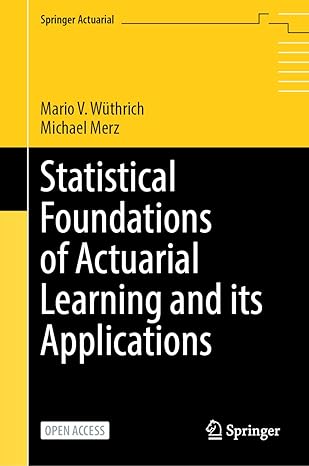
|
FreeComputerBooks.com
Links to Free Computer, Mathematics, Technical Books all over the World
|
|
- Title: Statistical Foundations of Actuarial Learning and its Applications
- Author(s) Mario V. Wüthrich, Michael Merz
- Publisher: Springer; 1st ed. 2023 edition (November 23, 2022); eBook (Creative Commons Licensed)
- License(s): Creative Commons License (CC)
- Paperback: 617
- eBook: PDF and ePub
- Language: English
- ASIN/ISBN-10: 3031124081
- ISBN-13: 978-3031124082
- Share This:

|
This open access book discusses the statistical modeling of insurance problems, a process which comprises data collection, data analysis and statistical model building to forecast insured events that may happen in the future. It presents the mathematical foundations behind these fundamental statistical concepts and how they can be applied in daily actuarial practice.
Providing practitioners with detailed guidance on how to apply machine learning methods to real-world data sets, and how to interpret the results without losing sight of the mathematical assumptions on which these methods are based, the book can serve as a modern basis for an actuarial education syllabus.
About the Authors- Mario Wüthrich is Professor in the Department of Mathematics at ETH Zurich, Honorary Visiting Professor at City, University of London.
- Financial Mathematics and Engineering, Financial Technologies
- Statistics, R Language and SAS Programming
- Probability and Stochastic Processes
- Applied Mathematics

- Statistical Foundations of Actuarial Learning and its Applications (Mario V. Wüthrich, et al.)
- The Mirror Site (1) - PDF
-
 Statistical Tools for Finance and Insurance (Pavel Cizek, et al)
Statistical Tools for Finance and Insurance (Pavel Cizek, et al)
Presents ready-to-use solutions, theoretical developments and method construction for many practical problems in quantitative finance and insurance, offers a unique combination of topics from which every market analyst and risk manager will benefit.
-
 A Basic Course in the Theory of Interest and Derivatives Markets
A Basic Course in the Theory of Interest and Derivatives Markets
This book is designed for an introductory course in the theory of interest and annuity. Each section contains the embedded examples with answer keys. It is suitable for a junior level course in the mathematics of finance.
-
 Innovations in Derivatives Markets (Kathrin Glau, et al)
Innovations in Derivatives Markets (Kathrin Glau, et al)
Pricing and hedging in fixed-income markets and multi-curve interest-rate modeling. Recent developments concerning contingent convertible bonds, the measuring of basis spreads, and the modeling of implied correlations.
-
 Mathematics of Economics and Business (Frank Werner, et al.)
Mathematics of Economics and Business (Frank Werner, et al.)
For all students who wish to understand current economic and business literature, knowledge of mathematical methods has become a prerequisite. Clear and concise, with precise definitions and theorems, this book covers all the major topics required.
-
 Financial Mathematics: Concepts and Computational Methods
Financial Mathematics: Concepts and Computational Methods
This text serves as a primer in financial mathematics with a focus on conceptual understanding of models and problem solving. It includes the mathematical background needed for risk management, such as probability theory, optimization, and the like.
-
 Financial Numerical Recipes in C++: Applications in Finance
Financial Numerical Recipes in C++: Applications in Finance
This book provides a good deal of useful examples and algorithms for people working within the field of finance, in C++. All the routines have been made to confirm to the new ISO/ANSI C++ standard, using namespaces and the standard template library.
-
 Mathematical Methods for Economic Theory (Martin J. Osborne)
Mathematical Methods for Economic Theory (Martin J. Osborne)
This book covers the basic mathematical tools used in economic theory. It emphasizes techniques rather than abstract theory. However, the conditions under which each technique is applicable are stated precisely.
-
 Numerical Methods for Finance (Robert Nurnberg)
Numerical Methods for Finance (Robert Nurnberg)
This book explores new and relevant numerical methods for the solution of practical problems in finance. It is one of the few books entirely devoted to numerical methods as applied to the financial field.
-
 Blockchain and Crypto Currency: Marketplace for Crypto Data
Blockchain and Crypto Currency: Marketplace for Crypto Data
This book contributes to the creation of a cyber ecosystem supported by Blockchain technology in which technology and people can coexist in harmony. The decentralization of the recording process is expected to significantly economize the cost of transactions.
-
 Math for Trades: Volume 1 (Chad Flinn, et al.)
Math for Trades: Volume 1 (Chad Flinn, et al.)
This volume represents the building blocks for math training. The goal of this volume is to get students prepared for the more advanced topics that they will encounter during their trades math education.
-
 Math for Trades: Volume 2 (Chad Flinn, et al.)
Math for Trades: Volume 2 (Chad Flinn, et al.)
This volume continues where the Volume 1 left off. Volume 2 increases the challenge with topics such as converting units and working with equations, perimeter, area, and volume. Once again the material is presented from a trades perspective.
-
 Mathematics for Finance: An Introduction to Financial Engineering
Mathematics for Finance: An Introduction to Financial Engineering
This book is an excellent introduction to Mathematical Finance. Armed with a knowledge of basic calculus and probability a student can use this book to learn about derivatives, interest rates and their term structure and portfolio management.
-
 Statistical Tools for Finance and Insurance (Pavel Cizek, et al)
Statistical Tools for Finance and Insurance (Pavel Cizek, et al)
Presents ready-to-use solutions, theoretical developments and method construction for many practical problems in quantitative finance and insurance, offers a unique combination of topics from which every market analyst and risk manager will benefit.
-
 Applied Quantitative Finance: Theory and Computational Tools
Applied Quantitative Finance: Theory and Computational Tools
Presents solutions, theoretical developments and method proliferation for many practical problems in quantitative finance. The combination of practice and theory supported by computational tools is reflected in the selection of topics.





